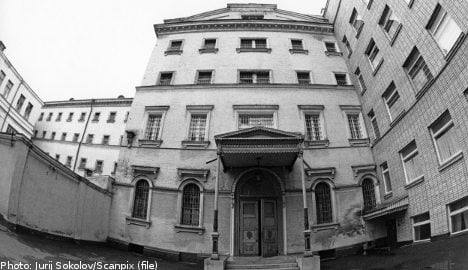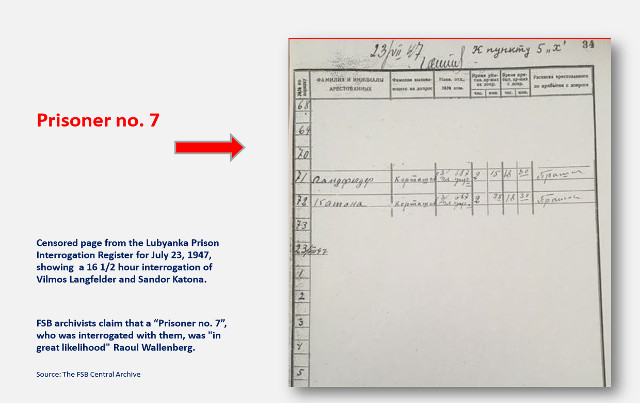In 1957 a former German prisoner of war by the name of Ludwig Hunoldt provided intriguing information about a Swedish citizen he had encountered in the Soviet captivity.
According to Hunoldt, this meeting took place under rather grim circumstances in 1950, in Vladimir prison, the Soviet Union’s most forbidding isolation facility, located some 150 kilometres northeast of Moscow.
In a formal interview with former Swedish diplomat and foreign ministry cabinet secretary Leif Leifland, conducted in Bonn, Germany on July 15th, 1957, Hunoldt explained that he had been arrested by Soviet troops in January 1945.
After an odyssey through various Soviet prisons, he arrived in December 1948 in Vladimir. Leifland’s protocol outlines the story from there:
In January 1950, after suffering an epileptic seizure, Hunoldt had been taken to cell 57 of Vladimir’s hospital section. After some time, another prisoner was brought in who had just undergone surgery on his gall bladder.
This prisoner, who remained in cell 57 for five days, told Hunoldt that his name was “Eriksson” and that he was a Swedish citizen, married and that he had earlier resided in Uppsala.
He had been arrested in the autumn of 1944 in Sofia, Bucharest or Budapest – Hunoldt could no longer recall “Eriksson’s” precise statement about this – together with two other Swedes who were apparently also being held in Vladimir.
He did recall that “Eriksson” had said that he and the other two Swedes had worked on behalf of a Red Cross organisation to handle the transfer of the German diplomatic representations in the Balkans (“mit der Abwicklund der deutschen Gesandschaften betreut”).
In this connection, they had been arrested by Soviet organs and had been taken to Lubyanka and later to Vladimir, after having been sentenced to 25 years for espionage.”
Hunoldt reported further:
“’Eriksson’ expressed his amazement and bitterness over the fact that Soviet authorities should keep him – a citizen of a neutral country and a representative of the Red Cross – detained year after year.”
As far as Hunoldt could recall, “Eriksson” had not mentioned the names of the other two Swedes who supposedly had been arrested with him.
According to Leifland, Hunoldt described “Eriksson” as about 52-years-old, with “light blue eyes, an oval face, short shaved hair and broad shoulders.”
He spoke German fluently and it appears that his mother was German. It is possible that he was a German citizen who was married to a Swede, but that – in spite of his statement to Hunoldt – he did not possess Swedish citizenship himself.
“Eriksson” is quite clearly not identical with Raoul Wallenberg or any other Swede known to have spent time in Soviet captivity after 1945.
“Eriksson’s” case profile, however — a Swede arrested in Eastern Europe while working in an official capacity for the Red Cross or similar aid organisation — could have easily led to confusion with Raoul Wallenberg.
Hunoldt told Leifland that “Eriksson’s” physical condition was very poor and that he was removed from his cell after a few days. It is not clear if Hunoldt’s recalled “Eriksson’s” last name correctly.
Another witness described meeting a man some years later in a Russian prison camp whose personal story and physical description appears strikingly similar to the man Hunoldt encountered in “Vladimir”.
The witness gave that man’s last name as “Johansson”, with his wife residing in either Uppsala or Lund.
In his personal comments about the witness statement, Leifland stressed that Ludwig Hunoldt made a very reliable impression.
Swedish officials had not learned of Hunoldt’s experience directly, but through a fellow prisoner named Hans Schmidt who had been interviewed by Swedish authorities in connection with his stay in Vladimir prison.
Schmidt told investigators that Ludwig Hunoldt had told him already during their time together in Vladimir prison about his meeting with “Eriksson”.
In 2001, two independent experts to the Swedish-Russian Working Group which formally investigated Raoul Wallenberg’s fate in Russia, Dr. Makinen and Ari Kaplan, conducted a thorough database analysis of foreign prisoners held in Vladimir for the years 1945-1973.
They confirmed Hunoldt’s stay in Vladimir prison in 1950 and they further confirmed that on several occasion he had been held alone in a cell.
No prisoner card with the name “Eriksson” was found in the central prison registry.
If Hunoldt’s account is true, this would suggest that the card for “Eriksson” is missing or that it was intentionally removed.
Such removal of cards has been confirmed for several other prisoners known to have been imprisoned in “Vladimir”.
Requests to Russian authorities to provide information about “Eriksson” and his colleagues have yielded no results. The Swedish foreign ministry has also been unable to identify the men.
It has been confirmed that in the autumn of 1944, Swedish diplomatic representatives in Bulgaria and Romania oversaw the planned departure of German diplomatic personnel from these two countries to destinations such as Turkey.
The International Red Cross and other aid organizations monitored and assisted the transfer.
Most of the German and Italian diplomats under Swedish protection at the time were nevertheless arrested by Soviet forces before reaching Turkish territory and they were taken to Moscow where they spent years in imprisonment.
Therefore, “Eriksson’s” claim that he was detained in connection with such transfers appears credible.
If he lived as an expatriate German or Swedish resident in Eastern Europe, his disappearance would possibly not have attracted much attention in his home country (Sweden or Germany).
Inquiries to the Red Cross have also not provided any conclusive information. However, it is not clear from Hunoldt’s statement if “Eriksson” indeed was employed by a “Red Cross organisation”.
Proper identification of “Eriksson” and his colleagues would be of great help to researchers studying the fate of Swedish citizens in Soviet captivity after 1945.
Susanne Berger
Susanne Berger is a US-based German historian heavily involved in research into the life of Raoul Wallenberg, the Swedish diplomat who helped prevent the arrests of thousands of Hungarian Jews during the Second World War.




 Please whitelist us to continue reading.
Please whitelist us to continue reading.
Member comments